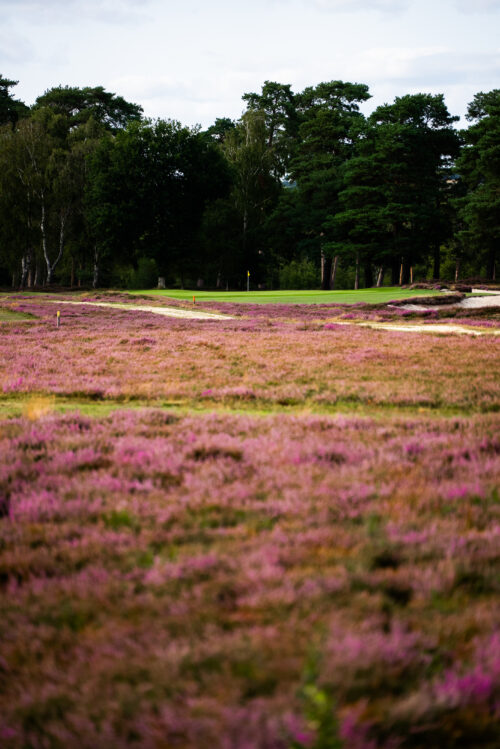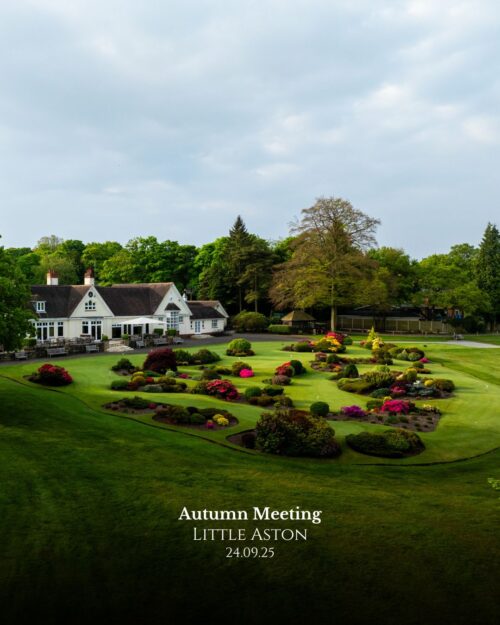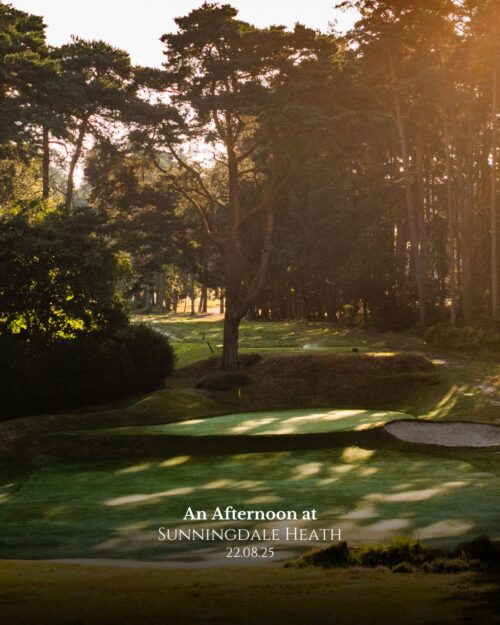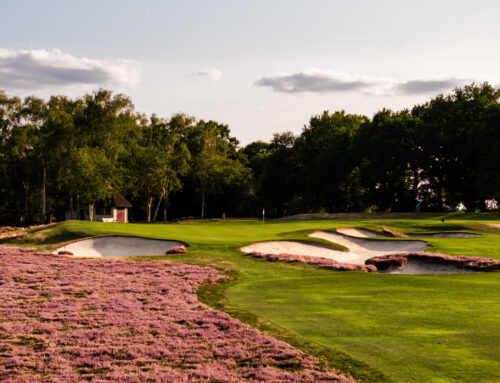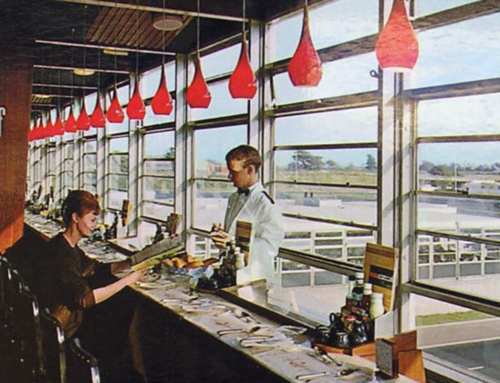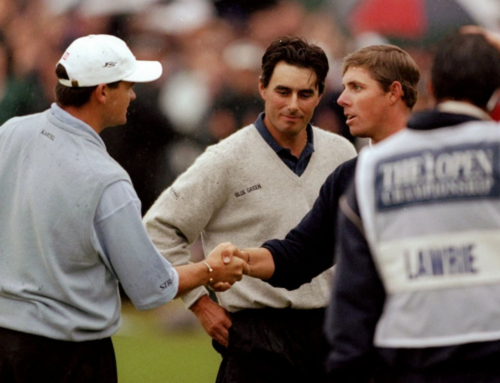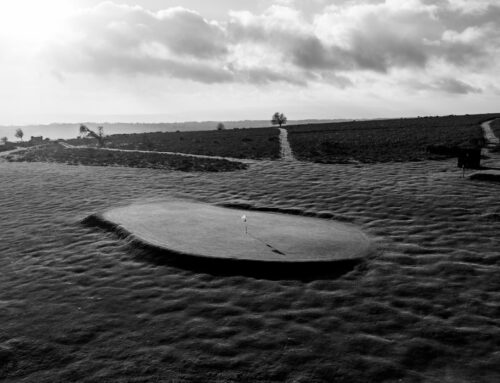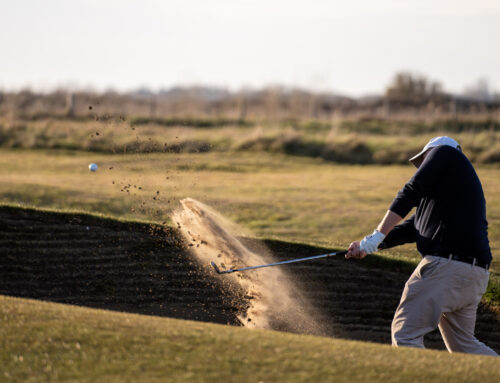hello and welcome back to the quick jar golf podcast I am Tom Mills and today we are entering a series of podcasts and
films that will go on for the next six to seven weeks so this first podcast is with case Collard who is the head of
sustainability at the RNA and we met up with case in Eindhoven after playing Eindhoven which was the first stop on
our trip to the Netherlands this is going to be the first of five podcasts that we do on the Netherlands trip and also launching this evening is
the first of seven films on our trip to the Netherlands and that will be coming live tonight at 7pm that’s Tuesday the
17th of January so keep your eyes and ears peeled moving forward over the next few weeks for the content that we’re
releasing over the Netherlands big shout out to our series sponsor FootJoy who helped make this dream trip a reality
we’re very lucky to get to partner with such an iconic brand and photo are the number one shoe on tour they’re trusted
by more PGA players than any other and have been since 1945. little interesting
footnote uh Walter Hagan selected FootJoy as Footwear of choice for the 1927 Ryder Cup in 1928 Johnny Farrell
was the first player to win a tournament for Joy shoes beating Bobby Jones at Olympia Fields unfortunately I’ve gone
on to win over 6 500 more tournaments since and whilst the designs have changed over
the last hundred years the ethos of great tradition and classic design remain constant the premiere series comes in five
designs with a Packard tarlo Flint field and Wicklow for 2023. once again we’re
delighted to be partnering with FootJoy in the series and we’re a huge fan of their products so a huge thank you for them for supporting cookie jar and
helping us bring this content to you it means a lot to us for more info on any photo products head
over to at FootJoy Europe or visit www.future.co.uk and without further Ado
it’s over to our first pod from the Netherlands case Collard
our Rich made a form of recording
podcast in great locations just gets better and better we are currently I’m joined I should say by Bruce on my right
good evening welcome back to the cookie jar golf podcast bridge and now we are joined on my left by case
Collard case good evening boys where are we sat we are set at the committee room
at eindhoven’s golf and uh I’m very delighted to have you here start of a great tour as you
corrected us earlier there is no golf club in the name is there no correct I think we’re the only one in the
Netherlands the only golf club that doesn’t have the word Club in its official name so it was founded as
eindhoven’s Golf and it has always remained eight of the golf so we are pretty unique in that as well I was
really kicked out the place when I sort of showed an Instagram post to you earlier and you said there’s no Club there’s no Club I’ve told you there’s
three times yes it was so ridiculous I’m glad you’re you know taking heat of the audit function of it we’re not going to
do a full Deep dive on Eindhoven today because uh we’ve got films coming up we’ve got a podcast Galore Etc so I will
cover it in its fullest but I think it’ll be remiss not to say what a great day we’ve had there today first hit of
golf in the Netherlands and uh yeah what a day one of the day in case thank you so much
for setting it all up and um and having us um it’s been fantastic yeah it’s been
my pleasure to to host you guys here at Eindhoven and to set up all the other top five courses in the Netherlands for
you so I hope you will enjoy the coming four days as much as you did enjoy today
can’t miss can we yeah um case we want to do this podcast for a while talking about sustainability as
the chairman of the sustainability committee within the RNA um but before we get too close to that
subject I thought it would be quite helpful to talk about your background in golf golf in the Netherlands a bit in general and also what you do for work
outside because I think there’s there’s some synergies there so am I right and thinking you joined Eindhoven in 86 you
said to me yes you’ve been here a while was that the start of golf for you uh no that wasn’t a start I had played golf
for a number of years before and my parents were members here at Eindhoven and I joined a local Club in our village
because all my friends played golf there and in 1986 they went to another course
there was a new course built and I thought well there’s no use to moving to that course now and my parents are here
at eindhoe and so that’s when I moved to Eindhoven yeah correct and before that I
my my parents used to send me to England every summer and the family I stayed
with the guy was a golfer so that was at Market Drayton Golf Club oh yeah okay so
into Midlands pretty close to you guys and that’s where I started my golf
career if you will and the funny thing was my dad was an agricultural machinery and he was a
non-executive director of a company there in Market Drayton which was called skh silopian Kenneth Hudson limited and
they this guided director which was the family I stayed with every summer he
always took me to the Royal Highland show and uh I was very lucky because that wasn’t Edinburgh on the show
grounds next to the airport and he showed me all the Great Courses in East Lothian to start with so I the first
experiences I had on a golf course outside of the Netherlands was at Newfield and Gillen one and two and
loughness knew and uh these fantastic fantastic courses yeah yeah so I was
very lucky from the very start I guess incredible stuff and then you’ve played
quite a bit competitively through the Netherlands obviously things like the foursome Club of Holland you hold a good
handicap you play a lot was it always just a a big amateur Pastime for you just getting better playing the game
what were the sort of things that really sort of sucked you into the game itself
um I’ve always been pretty much a traditionalist I think and becoming a
member of the of the foursomes Club of Holland was was a big thing for me because that’s that’s the the summit of
traditionalism in in golf in the Netherlands I suppose and uh let’s say of the 10 Dutch RNA
members nine of them are members of the foursome’s club as well so through to all the foursomes club members I have
canoperative and the whole volunteer they were my proposal and second Earth for the RNA so that took me into the RNA
as well that brought me into the RNA as well so I’ve been really really privileged and lucky yeah in that extent
I’ve never been an extremely high level competitor or anything I mean I played
on the first team here but only for a couple of years and uh I’ve never played big International matches or stuff like
that so no not up to that extent but uh I’m happy I can still play to a handicap
of one so I’m I’m very happy it’s too low for me actually but there you go
brilliant um and and then obviously your involvement with the sustainability committee
knowing what you do for a living did that come about partly because of what you’re involved in into professionally
or I guess so I think it’s the combination my work I I work in ESG
Investments so uh there’s a lot of sustainability involved there I run a
private investment Fund in renewable energy and we invest someone else’s money by the way in around two topics
one is the value chain of photovoltaic solar and the other is industrial LED
lighting so I do know what’s going on in that world and at the same time the
other side I was on the greens committee here at Eindhoven for 14 years and in
the general committee for 10 years and I did the same at golf club the Domo I was on their greens committee for 10 years
so I knew quite a bit about it we had the Dutch Women’s Open here at I don’t and I was on the championship committee
responsible for the golf course so I knew a bit about that and uh so somehow
they found out at the RNA I guess and uh they approached me whether I wanted to join their sustainable golf committee or
sustainability committee as it was called at that time okay and uh so I joined four years ago and I start
chairing it after uh Charles Harrison’s term was up he was the past captain at
Sunningdale and he sadly died earlier this year lovely man but he asked me if
I wanted to succeed it which I did and uh well the rest is history basically yeah and is there a big thing with with
obviously the Netherlands you know you guys have some of the as an outsider it would seem some of the
strictest agronomical sort of restrictions around how you can operate and what you can do you guys over here
are kind of pretty much at the Vanguard of sustainable Agronomy and Course Maintenance would you say yeah I think
so it’s it’s something typically Dutch which I’m not against don’t get me wrong here but I believe we always want to be
the best pupil in the class right whereas I think hey guy being number two or three would be good enough as well so
that means that that’s a geocertification for example was already here for a long time before the rest of
Europe has started to uh to work on that and uh but what I did actually I my
personal belief when the committee at the RNA was still called sustainability committee I thought it was just slightly
too much on the tree hugging side if you catch my drift and I thought let’s think
this over very clearly because what we are really good at that the RNA is a grand me and we arguably have the best
agronomists in the world we employ them they run our championships and what have you so I thought if we could practice
sustainability through agronomy then we could really influence things
whereas if you speak about do you have LED lighting in in your light bulbs in
in the clubhouse or are you flushing your toilet with rain water I mean the law will take care of it isn’t it yeah
law will take care of that anyway so what we did is two years ago or when
Martin Slumbers entered the RNA and succeeded Peter Dawson he introduced a strategy for the RNA as a whole as as a
whole business for RNA limited basically and this strategy was renewed Last Summer
and I took the opportunity to change our strategy a bit as well so to move
basically into a sustainable Agronomy as our main topic got you yeah so before
there was a lot of stuff that would be on the peripheries for clubs about like you know electric charging points in car
parks and things like that and it’s now like just let nature run its course now like
yeah I guess that’s still important part of it is that maybe transitioning over to more electric mowers and and um you
know Course Maintenance tools I guess is does that still form part of it in a way it does it does basically uh what we did
when revising our strategy is building our strategy or basically our tactics
and and bring it into practice around five pillars so the first one is
sustainable Championship Agronomy so running our 29 championships including the open and the Women’s Open and the
amateur and what have you the second is a sustainable Agronomy services so
Commercial Services we are setting up to bring out into the country to clubs to
support clients you’re using them you’re using it at Blackwell at the moment Alistair bags and yeah so we started
this in GB and I and we are intending to go into Europe in in half a year’s time or so so that’s the second the third is
Golf Course 23 30 which is the research program around sustainable agronomy so
basically we ask our Affiliates the RNA Affiliates
to come up with plans but they need to be very specific boots on the ground ready to use Solutions we’re not after
all sorts of research where the researcher says at the end of his program fine and now we need even more
research that’s not what we want we want practical ready-to-use solutions for the
green keeping staff for the club managers Etc so that’s the third we do then the fourth is a green keeping
education and scholarship program around sustainable Agronomy because I think it’s important that green keeping
becomes more sexy again if you will because at this moment it’s very hard to get to to get new green Keepers and I
think they well they they really should be taught how to do it differently
because quite often they are they have been educated as Farmers if you will and
well at least in Holland I’m uh it’s slightly better in the UK but in Holland
it’s well there isn’t hardly any real green keeper education so they think it’s Farmers but as famous agronomists
said before if you well think like farmers and do the opposite that’s basically what you want to do in
greenkeeping and uh so that’s that’s that’s the fourth
pillar and the fifth is called Green links which is our program around sustainability at the Open Championship
and and the Women’s Open Championship so that’s a bit on the softer side so I’d say 80 is agronomy based and 20 is
around like uh uh zero waste to landfill or Source all your produce locally or
make sure that the players are being transported in electric cars being
charged by our own solar arrays yeah just like stuff like that and no more
plastic water bottles on the golf course and all sorts of stuff like that so yeah
those are the five pillars so it’s it’s quite a change compared to uh to what we previously did did it’s quite
interesting though in a sense I mean I remember vividly chatting to you about this earlier in the year case when you were telling me about how there’s this
great Synergy in terms of what clubs and and um hu’s word consumers but basically
people who are playing golf you know whether it’s as members whether it’s the touring golfer visitors generally are
looking for in terms of the surfaces they want to play on if you want more resilient grass types and Ergo better
surfaces year round um that also plays into the sustainability agenda which is
you know yeah you’re you’re kind of the the agronomical aspect yeah it’s interesting you say that Bruce because
um I always say if you if you want it in one sentence what do we do we try to
deliver proper playing Services based on less water less fertilizer and less pesticides that that’s bait that’s our
main goal that that we are trying to achieve which means that uh the green
keeper uh needs to practice drier green keeping and if you were to divide them
let’s say wet green keeping is slightly easier than dry green keeping you need to be slightly more on top of your game
when you do the drive why is that you can throw more fertilizer you can push the greens to the edge but then water
them heavily you can start uh you can cut them shorter because you can let get more nappy grass is it about
getting more more of the finer grasses into the green so it is it is that the
grass grows more easily but but it has to do with the farmer type of thinking as well because a farmer’s son thinks in
harvesting in Green in rich in much in whereas if you go to a proper golf
course it it’s it’s dry it’s it’s fast it’s firm the grass doesn’t grow that
quickly and there is no Lush grass around it so very thin it’s very fine
and it’s all being produced to make the ball roll evenly and properly Etc
whereas on a wet golf course it’s much more difficult to to to to to to to to
get to proper green speed or you have to cut them really very low but if you have
to do that the lower you cut your grass the lower the root the shorter the root structure will get which makes the
grasses more prone to diseases and and what have you so it’s it’s it’s it’s perfectly
that way because I guess you know try and tie a few threads together you know
we did a really good podcast with a greens chairman darigara here at uh portmarnock and obviously they’re very
rich in Fescue so they can cut at four mil and they can have billiard-like surfaces to put on you know it’s like
cutting on this table Yeah whereas you go to a club like Blackwell which is not particularly high in Fescue count and
yet to get the same green speech you’d need to cut them significantly lower how much of this is determined by the land
you’ve got the golf on versus the work the green keeper can do to get more finer grasses into the ground very very
valid point uh I’d say uh there’s a great if you if you are lucky enough to have your course based on sandy soil
like we do here at Eindhoven so heathland style golf courses are normally based on very dry sandy soil
which is perfect which is not exactly the same as Seaside courses as links courses because they’re pH 10 tends to
be much higher up here the soils are much more acid but that’s an advantage as well because
only the very fine-leaved grasses will will grow there and that is what you
want to get rid of the POA annual who is in general let’s say the well who is the
general enemy yeah yeah and uh in order to get a PO annual green up to a proper
speed you would have to cut it down really shortly and that
shortens the root structure again which which yeah makes your green weaker and
more vulnerable whereas if you cut your uh your your fine leave fescues and
bends on four mil or even four and a half and you keep them dry and you roll
them regularly Etc it’s agronomically much more responsible if you will but
you can still come to the same types of green speeds whereas I’m not a big fan well I like putting on quick greens but
I think the proper regular membership speed would be around nine or nine and a
half as most you want to go for the amateur black like you experienced today here at Eindhoven and uh not not much
more than that and uh if you take the the Open Championship for example uh normally we don’t go over 10.
because of the simple fact that especially at Saint Andrews at the 11th we can’t hold the ball on the green
anymore this year we had a slightly different approach we said let’s bring them to 11 unless the wind is picking up
but it was flat calm on Thursday Friday Saturday and Sunday so hardly any wind uh so we had our green speed slightly
higher than we would have normally around 10 6 10 7.00 ones were like what 12 or 13 in Parts
yeah but what what the real uh what the real deal was uh the firmness of the
golf course and of the greens and the aprons particularly
normally a fast Golf Course would clack it’s the Clack impact hammer that that
you measure it with so the value would lie around 125 maybe or 130 that’s
really firm and we got it up to to way over 155 this year which yeah but it
means these guys are so good because they generate such high spin rates their
their swing speed is so high so the spin rates are much higher so they can they are still able to control the ball
whereas at Muirfield for the Women’s Open for example their swing speeds are slightly lower so their spin rates are
slightly lower so we have the greens at 125 there so that that’s yeah it’s but
but but yeah I think the the golf course at St Andrews this year was a perfect
example of very sustainable uh green keeping and also on for a very
challenging golf course and it was quite amazing what cam Smith did on the Sunday but but the rest was incredible of the
field there weren’t any 62s or 61s or what have you but he shot an incredible
good round and he was because we really tucked away the the pins in very quirky
corners and it was really difficult but it’s a great Championship to watch I
think you know just just jumping off topic of sustainable green keeping for a second number you know reflecting back
on that open there was a lot of panic leading up to the tournament that the professionals were going to bring it to its knees and we didn’t want to see that
happen to the old course but ultimately you want to see the best tournament don’t you you want to see the best you want to see the best players at the top
of the leaderboard and you want to see a great tournament that’s a great spectacle and I think we could deliver it the scores were low but there wasn’t
much wind I don’t know where you stand on that I don’t see this has been protecting par at what cost to the
world’s best players I don’t think it achieves a huge amount do you no I fully agree with you I I’m not always too
happy about well let’s say the way the Americans go about this try to make your golf courses as hard as you possibly can
to make sure no one breaks par that’s not a great a great deal but the majors
have been great this year because we’ve seen things yeah I would say actually and there was a there was a great episode with Jeff Shackleford and Andy
Johnson on the Friday talking about the four majors of the year and the fact how they delivered so well because you know
it was actually used a great leaderboard and they were they weren’t ridiculously penal golf courses so just a bit of a
distraction there yeah how much is this is on the the golfer’s expectation so how much of sustainable green keeping
ultimately is a result of high expectations of the club golfer
people want to see 11 or 12 on their Greens on a Saturday morning how much does the everyday golfer need to
probably relax their own expectations around course presentation do you think I think they need to be relaxed very
much and I think it’s it’s the duty of of every golf club and every committee Etc well educate them if you will on
that because we’re not in America we’re not on a golf course that’s on television every day we’re not it’s it’s
slightly different here and I mean the pace of play will go up tremendously if
your greens are way too quick and uh so so that’s why I said I I think nine nine
and a half for regular membership play is more than enough it’s more than enough and then for your Club championships fine you you give them an
extra cutter you give them an extra Rule and you add another foot well fine huh then they are ten and a half well
excellent but but yeah that I think 99 and a half is absolutely fine and I
think we should try to educate golfers around this because the trueness of the role of the ball
that’s what it’s all about as long as it rolls out and far away yeah I mean it’s
funny isn’t it in a way everything we we’ve sort of been talking about over the last 10 or 15 minutes really it’s
it’s similar to debates in a slightly different although obviously connected Topic in terms of
course architecture and how you know there’s a lot of courses now and undertaking Master plans and getting
in professional Architects to look at stripping out trees and trying to recapture some of the the wisdom of the
original architects who who laid out these courses quite often until that golden age in and around 1930
particularly in Holland and it seems to be the same with green keeping in that we’re we’re recapturing some of that
ancient wisdom about making the courses drying them out and encouraging the
finer grasses that are more resilient to take over and actually move away from not wanting to lay the blame too much at
Americans but the the image that may be quite a lot of people were persuaded by over the last 30 40 Years of seeing
these lush green grasses um on the on the sort of television on these tournament courses where you know
they are there’s a huge amount of of of money and and these sort of Natural Resources going into presenting them and
actually it’s quite sort of artificial and in a way it’s not really benefiting the game for Augusta is almost the worst
thing in some respects for what you’re trying to achieve because it’s the pin-up it’s the poster girl for that’s
an unattainable standard right and it comes at a time of the year when people are absolutely ready for that yeah that
image yeah but one mustn’t forget I mean all the technology that’s behind that
and their sub air systems on the greens and what have you for nice on the um as Alias to make sure
no they all do that and they put all sorts of additives in the water so to
make it color more blue and there’s all sorts of stuff going on which is fine with me but what I must say about
Augusta National uh by the way is that uh they over the past years they’ve kept
their course much firmer than they used to do in the old days so so what which I
believe is a general Trend I see in America on the top courses is that they
bring it much more back into the original state and they tend to go faster and firmer as well do they yeah
because because it’s not only an advantage from an Agronomy perspective it’s also a huge Advantage from an
architectural perspective perspective because in the old days it was very important The Architects worked with the
landforms and you needed to have your ball exactly on that spot otherwise you couldn’t get to the green or to a
certain pin or what have you whereas if it’s much softer it doesn’t matter it’s just like well
playing the darts and I think in America you see the trends now with let’s say
Philadelphia Cricket Club and Marion and all these clubs uh also in in California
they tend to keep their courses much firmer than they used to which I think is a very good Trend because well it’s
not only from an Agronomy sustainable Agronomy perspective but it brings the architecture alive doesn’t exactly the
width the angles the slopes and everything like that because yeah I think the scoring as well there’s
been a number of sort of studies or just kind of statistical analyzes showing that disbelief
that we were all sort of laboring under the assumption 10 20 years ago that you need to make a course seven and a half eight thousand yards challenge the best
players in the world actually doesn’t hold water that argument because they will still go and shoot 30 under I mean
yeah but Kappa lure or wherever it is in
Hawaii where they’re stretching the course out north of 7 600 yards and yet they’re still quite regularly will go
and shoot north of 25 under around there yeah it’s actually the really firm fiery
courses that’s like the Shinnecock Hills where it’s okay granted maybe they they flirt with losing the golf course Zach
Johnson that’s actually where you know the best players in the world are really under duress it’s quite funny if you if
you take Royals and George’s last summer for example uh we were very unlucky whilst preparing
the golf course because it had been raining raining raining a lot in the week up to the event and I remember
speaking to Alistair backs quite a few times and he said how’s it going how’s it going and he says well yeah it’s
still very I wanted to go there but I couldn’t go due to kovid I wasn’t allowed into the UK so I had everything
booked and everything nice and Evelyn she wanted to go as well but we couldn’t go there so I had them on the phone
regularly and uh uh on the Thursday and the Friday it was still way too moist
way way too wet and then on Saturday he said well I’m pretty okay now but on
Sunday he said this is really the way we wanted the course to be the entire week but okay hey ho I mean when it rains it
rains and uh but but still uh Royals and George is always it’s very nice and
quirky and and the ball could go several ways uh unintendedly and and what
happens yeah that’s part of of of the deal if you play there uh and I think
even in wetter circumstances they they they really managed to get the golf course up to a good standard and uh in
the weekend it was really what they really wanted uh uh our Agronomy staff and uh so then they worked very closely
together with the new hat green keeper there and uh what’s his name Paul Paulson yeah exactly
podcast yeah the Rockstar yeah the rock star
yeah absolutely on the oh did he oh yeah it is like full
regalia with the hair and stuff he’s yeah once Matt never forgotten character
um just just looking at some of the stuff you talked about there helping clubs there’s a couple of issues that I
guess from a sustainability point of view are pretty key one of them is trees on golf courses and tree removal because
where firm conditions are complementary to the architecture trees which are
sometimes seen as good for the environment are often in opposition to good architecture
an entropy and as trees grow in and canopies and everything like that
is there like a sustainability or an RNA stance when it comes to was a sustainable approach to trica okay
um in general I would agree with you that um but coming from a a heathland as well
as a Woodland area at Eindhoven it’s it’s not that I’m a big hater of trees
or anything and I know Colt was very specific about this huh okay if if there
needs to be a tree okay fine but not too many of them and what have you um I think
what we try to achieve is uh sustainable proper playing surfaces but we try to
reach higher states of biodiversity as well so the combination of the two so
I’m not necessarily against trees or anything as long as they are not too close to the golf course that’s
basically because they can be restrictive to the air for you yeah the light which then makes it harder to
generate the grass which means you might to use more chemicals to get the the playing surfaces you need right yeah
correct yeah that is correct so what we did here at Eindhoven for example uh in in in in in in the winters of 2015 and
2016. uh well it’s a larger State as as you’ve seen today but we took out 3 800
trees and oh 3800 oh hang on a minute and then we
did uh drone flights in the spring when when when the the trees got their new
leaves on the tree Etc and we Flew Over the golf course with it with a drone and we just couldn’t tell the difference wow
so yeah and the trees are healthier because they’ve got more room then as well so this is a big part that gets
lost isn’t it is the idea that we need more and more trees but actually they’re all then competing for the same same
like the same water and I think you made a great partner out in the course you took us over the back of um the 16th
Team box yeah 15 and 16 the 15th green 16 t-box Aaron pointed out at what used to be
um a sort of body of water I don’t know whether you call it like a lake yeah essentially it’s now become quite marshy
because there’s just thousands of trees that are all competing for for the same water really correct yeah we did all the
the the the um we did some research on that and uh it came out that the abundance of trees
there they consumed so much water that the water table in in the Pont in the
lake itself uh suffered because of it and uh so now we have decided not to
remove all trees of course we’re not going to remove all trees but if you get rid of of two men well there can be too
many yeah and if you take them out and you get and and remove all the low scrub
and what have you uh not only your golf course looks much better but you get
much better agronomical circumstances as well you create them and uh in this
specific example uh the lake the pond will benefit of it as well because the
water table can get higher again so it’s basically killing three birds with one stone you have to be more clever don’t
you I mean you talked about it I think in the Netherlands you guys can’t use chemicals or fertilizers that would is
it scrubs what what the the safer Shaffer grubs yeah so instead what are you doing about
that so you can’t yeah they’re like little insects on the fairways right correct in in they normally uh arrive in
May June just in two weeks time and then they’re all gone but the damage is done
then because they lay their eggs in in in in in in the grass and they develop
into larvae and these larvae they feed themselves on the roots of the grass
and when the larvae are large enough around August September that’s exactly
when the crows and the Badgers come because they are very rich in protein and they like them very much so they
tear open your entire Fairway really yeah it’s a very good snack so you’ve
got all these bird boxes now along the fat the trees right yeah correct yeah that’s one of the measures we try we’ve
we’ve been trying every well all sorts of measures and one of them is if you
get sparrows on your golf course they like let’s say the Shafer grabs when
they are there in in May June so they they feed on them which which
basically uh makes that they can’t lay their eggs and bang There you go so
nothing out there yeah well then but the problem is that
the difference that you take the six iron salmon are actually worse than the divots that a badger will take so in
September time yeah but um yeah if anyone knows of how we can get some the sparrow migratory pattern to move
towards our indexes yeah that would be much appreciated yeah
exactly yeah can we um I mean you talked about things like education working with
green keeping again tying a few things together we recently did a podcast with John John McLaughlin who’s course
manager at wallasey he says you know it’s really hard to find good people he wanted something cut into it and I’ll
definitely Point people towards that episode but you know I guess what are the big things if you could sort of land a couple of
things with clubs or people that might listen to this podcast be them in America Australia you’re a Great Britain
what would be the sort of key things from uh sustainable golf point of view that you would say well do you know what
I’d I’d really love them to do this or are there any big secrets out there where clubs or you know green stuff
might not know there’s some resources there what are the kind of key things really you’ve got a cast of millions
you’re talking to here okay you can land a message with uh I’d say I mean
I think the program we’re running at the RNA currently uh is is is is quite good
at that because what we try to do is uh well education is one of our five
pillars and the education part is uh is very yeah is very important but
since like I said since most of the green Keepers in the Netherlands anyway
are being brought up as farmers and listen to Farmers but do the opposite is
the Cradle of the of of of of proper green keeping it’s also a matter of of of a mind
switch and that it’s how do you do that it’s because I can’t blame a Dutch green
keeper or some of the Dutch green Keepers that they think like that because they have never been taught differently and uh so we as RNA as a
governing body in golf worldwide or outside of America Mexico
we feel that it’s our duty to to tell the world and we’ve we’ve we’ve set up
all sorts of programs to to to make this more evident and to make this work and
to make this more visible especially because in the old days I think sometimes the RNA was was very modest
and it might be very well known in the UK and gbni but but not so much in Spain
perhaps or in Italy or in and and some of these places are the places that I maybe anti-sustainable aren’t they I
mean there’s places where we play golf yeah is that an unfair take I don’t know I’m not wanting to tee you up too much
case but that same discussion I referenced earlier um from earlier in the year I mean talking about somewhere like Dubai for
example which just took to us in the context of the discussion screams out somewhere that doesn’t seem very sustainable but it might not be
sustained in terms of the way they’re currently preparing courses but I think you were mentioning um earlier in the year there’s actually
different grass types in certain climates that you can actually encourage and you can still play golf there but it’s just not it’s not going to be on
the basis yeah I was I was referring to uh sustainable Agronomy services that we
are currently introducing we first did a pilot in Asia which was in the middle of
govid so that was a bit you know not ideal but Chris Gray our man in Singapore he uh he did some fantastic
work on that and uh I mean there’s also in those hotter climates there are all
sorts of fine-leaved grasses that are very drought resistant and and the past
palum is is one of them for example so it’s just a matter if a green keeper
doesn’t know that then why would he buy oh so they’re going to hot climates and just thrown down
you know Pioneer just like really Hardy grass throwing a load of water on it and it’s like there’s my golf course when
actually if they built it in a slightly different image maybe the more Browns the yellows
rather than looking for rich green verdant grass you’ve got a much more sustainable product on your hand it’s
it’s funny you say that I always in in let’s say in the sustainable golf team at the RNA when we have a new folder or
a new brochure or I say no this this is way too green this photography so they
start taking the Mickey out of them and saying oh is this brown enough is this brownie yeah
no but the point is that that if you want a mind shift a a different mindset
well you need to show and and you need to walk to talk don’t you so so uh
that’s why I think it’s important in our open championships which is being televised Etc
it shows nice fast and fiery courses if we can if we cannot bad luck but if we
can we should do it and they should be showcases because let’s say the Five
Pillars I just mentioned to you they are all interlinked aren’t they well at least the first four are very much
interlinked and uh yeah so it’s a championship Agronomy and it’s
sustainable Agronomy services and it’s the education part and it’s the green keeping part so it and and the uh sorry
the research part so there’s four of them that that are interlinked together and and they all should push towards
this goal and it’s not a one-size-fits-all solution I I get that
because in hotter climates of course you want to do different things and there are people that know so much more about that than I do but we have an excellent
Agronomy team and uh they are very yeah very good at this so
that’s what we are going to use them for or that’s what we are using them for yeah
perfect um case thank you so much for having us for
the linethaven today it’s been been very lucky to see the club it’s been a real
pleasure um I’ve enjoyed chatting about the sustainability stuff I’m sure there’ll be more on it as it continues to evolve
are there any kind of big commitments 2030 seems to be like a landmark year is that a you know Bruce will be very
disappointed the fact that I don’t know this but it’s 20 30 as that like sort of part of a a wider commitment around
climate and sustainability is there is that like a year that you work towards or anything because it’s just an ongoing
project now I I personally believe it’s an ongoing project because well 2030 was
just a DOT on the horizon when we started this uh uh two years ago and we
thought oh a scope of 10 years will be nice so let’s call it Golf Course 2030 but uh we don’t mind if people adapt uh
much quicker than that and uh what we see is let’s say the first projects that
came in they are about to be delivered as we speak so we had 65 projects and we
selected only 14 out of them because they needed to be specific enough ready Solutions can you
give us an example one is there any like sort of like really or is that all sort of wrapped up in non-disclosure and
stuff or no it’s no no no it’s well I um they are all uh on on our website as
well so at randa.org there’s a section on Golf Course 2030 but one of them for
example is uh about green keeping education and what should the colloquium look like Etc another one is how can you
manage uh let’s say proper grasses on Parkland courses for example because we
were just discussing there’s not any no the the the the sandy soil is not
everywhere so what should you be doing there what should be your grass selection there and just on that note
sorry sorry to interrupt but I think you’d like to him is that as as three members of of Blackwell Golf Club you
know Tom Tom Savanna when we got that that email um from Aleister Beggs on his report on
Blackwell I mean we obviously all quite liked it uh um but to hear so many other members
who we didn’t really think were kind of that passionate about you know kind of course Agronomy and and course
architecture and so on the number of people you’d hear in the bar say I yeah I thought I’ll just give
this a quick read and then 20 Pages later I thought oh my god I’ve read the whole thing yeah it’s just brilliant to
see to see that content that the RNA is kind of pushing out there and how so many clubs can benefit from it
particularly in a Parkland context as we’ve seen at Blackwell yeah well what we tried to do is to be bespoke which is
uh let’s say what you don’t see too often in the market although uh some
other parties say they are very bespoke it’s much more uh one size fits-all it’s
perhaps slightly exaggerated but but but as you mentioned by reading the report on Blackwell golf club uh yeah I think
it was pretty bespoke and what I heard back from your green committee members and from your from your head green
keeper as well is that they it’s it’s it’s it’s a very good report and they they
know what to do now and they they know how they can improve and they have applied all sorts of measures and they
are seeing the results quite quickly which which is a good thing and I’m sure your dad will like it it’s common sense
it’s just common sense approach I mean he was saying he’s absolutely he still talks about now it’s just astounded when
um yeah Alastair went along with the kind of little extraction tool and pulled out like a core of Earth and
talked about where the thatch was and yeah and pulled out a healthy core and then poured the water on the one with
thatch and it just sat on the top and didn’t go anywhere and they’re like wow this is yeah to look at the wrong things you know
we’ve evolved to keep looking at stint reading as a measure for how good our greens are rather than looking at soil
composition like you say biodiversity looking at Clegg readings looking at the
type of grass that we’re breeding in there to go okay great because even things like you know clegh is I can get
really firm green means but to what end is there what’s the substrata of the of the soil looking like it’s strange how
much is technology going to be a big part of this because you know it’s not it’s golf is never a Level Playing Field
is it if you go to an Open Championship venue they can give you moisture readings and any square inch on the golf
course if you go to your local Municipal it’s done much more by hand and by eye and by people who are used to it how
much is technology going to change that and level the playing field I think it’s huge on one hand but on the other I
should think that even a small Municipal Golf Course could have very
healthy and proper playing surfaces because I mean it’s not just the speed
it’s the length of your root structure so it is the quality of your root structure where it all starts isn’t it
and and you take it from there exactly and the let’s say the the stem readings
or anything that should only be the the final product of a very proper way of
managing your your your playing services and uh that’s that’s light it’s air it’s
it’s uh making sure that your drainage is is in order so enough uh top dressing
in and and frequently enough etc etc so it’s pretty basic stuff to to get a
healthy uh uh it doesn’t need to be too complicated it gets more complicated uh
let’s say if you want to bring it to Absolute tournament standards and that is where technology it can be of great
help but I do realize that not every Golf Club especially in these days can afford all sorts of uh fancy equipment
and and what have you so they as long as they stick to the to the top four or
five basic principles I’m I’m I’m I’m pretty sure they can deliver very healthy playing services and a healthy
playing Services is the excellent basis to get a good proper performing playing
Services playing services so yeah yeah it all starts at at the very close
refreshing it’s refreshing you know yeah and I think so many people
in the UK think about the golf season sort of starting to wane as you get into October and then maybe it goes quiet
until April May time but actually again it comes back to if you have the right
surfaces and you have um robust sort of root structures and you do the basic things like scarifying
and yeah training and putting sand down um you’re gonna be able to play all year round and it’s gonna be more pleasant
plus there’s always one thing uh the average green keeper absolutely believes
that let’s say uh in in your top 10 centimeters
um they need 25 or 30 moisture no way they don’t I mean yeah 18 15 is quite
enough and uh we went so at least the
healthy Grass Grows ideally around between 15 and 18 and they’re just like
the extra 10 for safety this is the insurance that’s insurance and it softens the way the course plays as well
it’s like you won them playing firm if you can yeah yeah and uh also I mean if
you have kept your golf course dry during the summer uh at least there’s more buffer capacity
for the for the Autumn Reigns to come and the winter rains to come whereas if
you start your Autumn with a pretty wet Golf Course well then it will go
underwater in no time exactly exactly yeah
well case um thank you so much for for coming on the podcast and kind of enlightening us
all in in the great work that the RNA and the sustainability committee or sorry I should say the sustainable golf committee very well um
well remember don’t call it Eindhoven golf club either Bruce because that would be a two-player I should leave you
to do this you’ve already let your partner down once today [Laughter]
and you know I try and shoot her on it at any chance an opportunity to talk about my golf but I’m going to walk past
it on this chance thank you so much for having us today and for joining the podcast it’s been an absolute pleasure
it was my pleasure and lovely having you here and please do come back after uh this winter and next winter when we have
cleared out more trees and the place will be even better so more than welcome
and good luck in the coming days at the other courses thank you very happy you
like the Netherlands and Dutch golf we love it thank you

